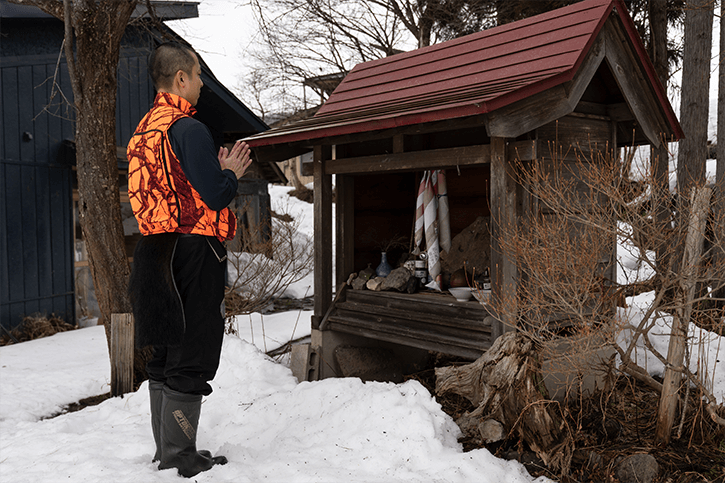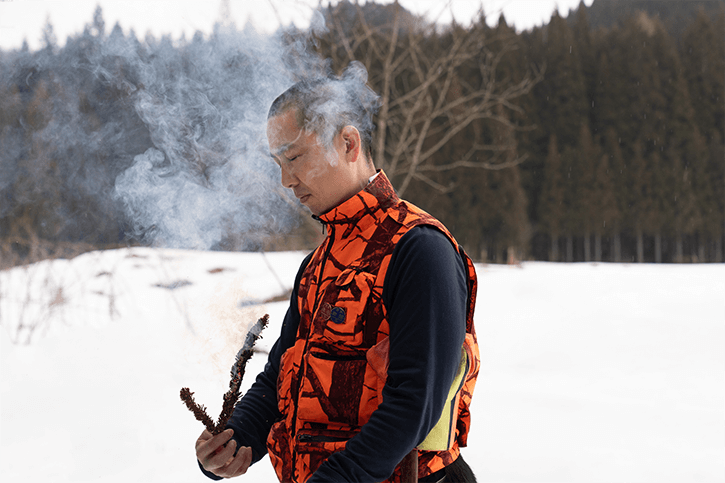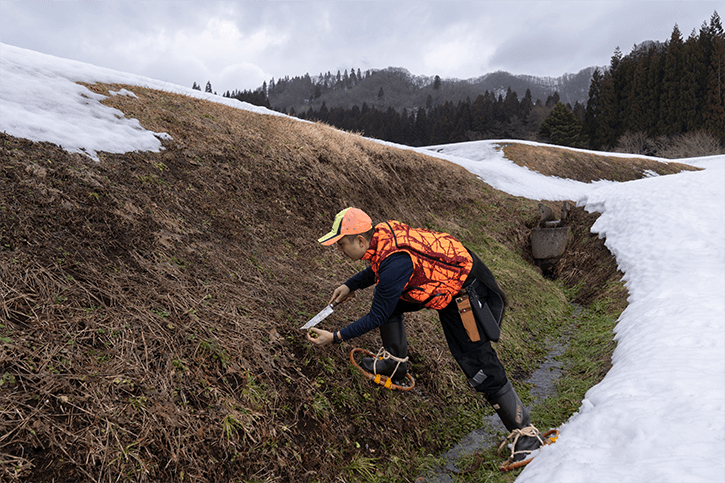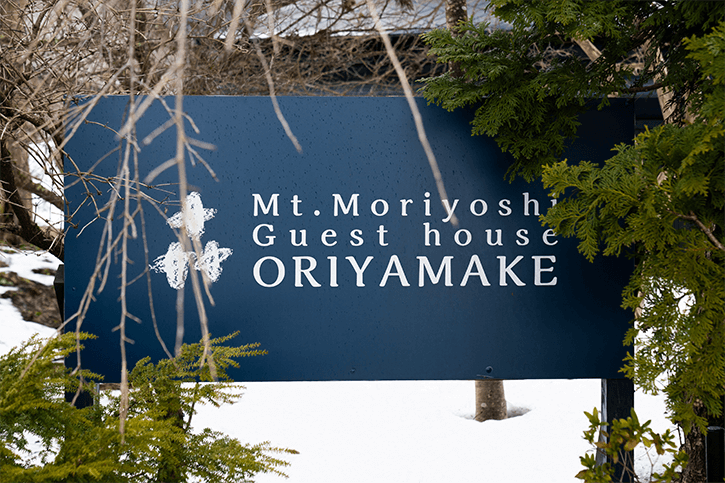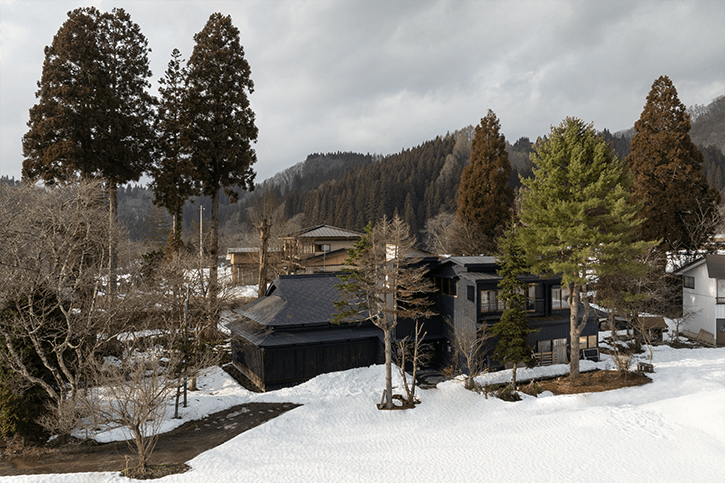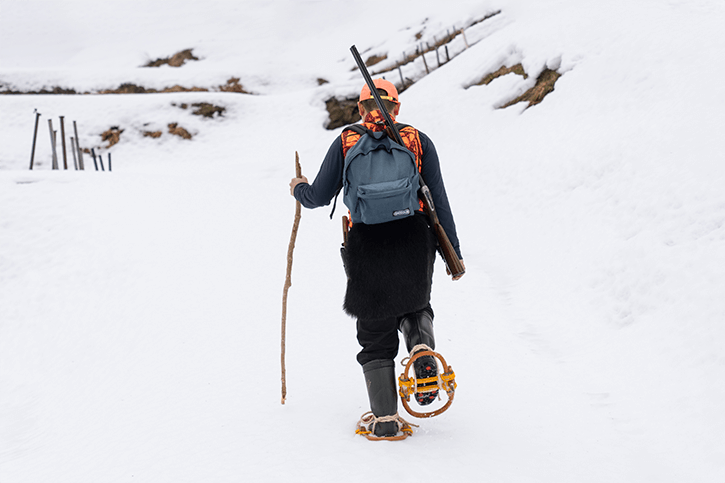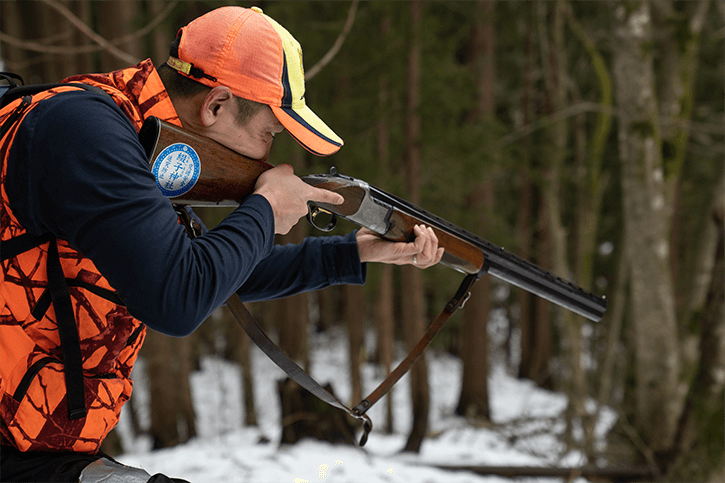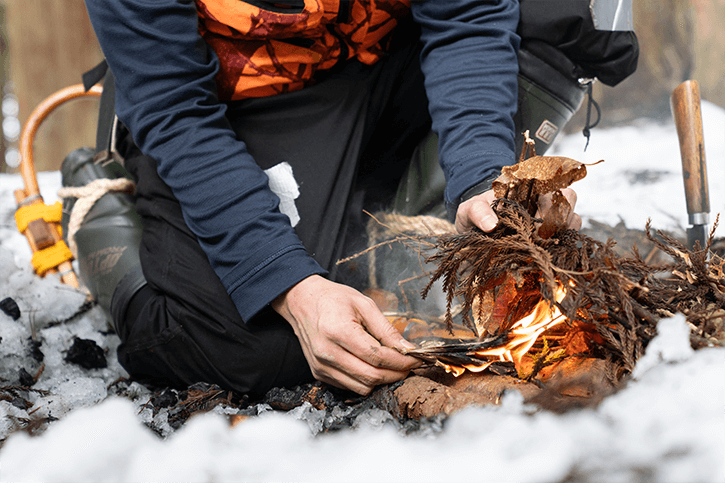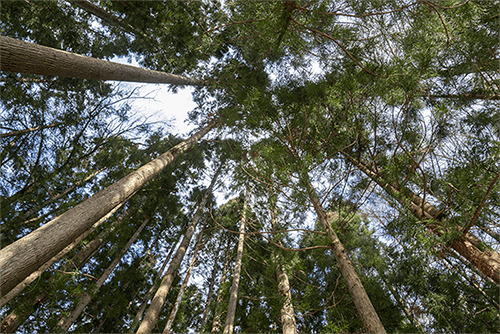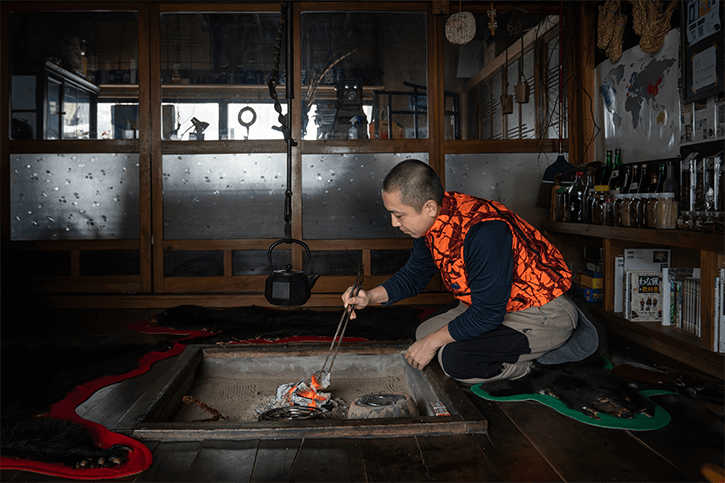
The foothills of Mt. Moriyoshi in Japan’s Akita prefecture are home to a group of mountain men known as matagi. Often referred to as Bear Hunters, the matagi live a life based on traditions that have seen little change over the past 1,000 years, hunting being just one part of a much wider range of activities they’re engaged in. Matagi hunt various wild animals for both food and to help with population control, forage for wild edibles and plants that have medicinal value, and perhaps most vitally play the important role of mountain steward for their communities. They aren’t nomadic hunters moving from one place to another after taking what they can, they care for the mountains and forests they live and work in, helping to encourage further flourishing of plant and animal life there.
-
01
The difference between matagi and game hunters
Before a matagi enters the wilderness to hunt, forage, or as is often the case, do both, they first offer prayers to the Yamanokami, or mountain goddess. They sometimes present a dried stonefish, said to placate the goddess, and burn a small branch of morobi, a type of fir tree. The morobi smoke is said to ward off evil and purify the matagi of the scents of civilization.
![Before a Matagi enters the wilderness to hunt or forage they first offer prayers to the Yamanokami, or mountain goddess]()
Before a Matagi enters the wilderness to hunt or forage they first offer prayers to the Yamanokami, or mountain goddess
![And then burn a small branch of morobi, a type of fir tree, said to ward off evil and purify the matagi of the scents of human civilization]()
And then burn a small branch of morobi, a type of fir tree, said to ward off evil and purify the matagi of the scents of human civilization
Throughout the year, matagi forage for a variety of edibles in the mountains, from the butterbur (fukinoto in Japanese) that start emerging from the ground as soon as the snow begins to recede, to nameko mushrooms in the autumn. There are also items of practical use, such as the bark of alpine birch trees, dake kanba in Japanese, which is peeled off of fallen trees in the spring. This birch bark that the matagi carry is extremely flammable, and makes starting fires much easier on the snowy mountainsides during the winter months.
![Foraging for wild edibles]()
Foraging for wild edibles
![Washing a fresh crop of butterbur in a mountain stream]()
Washing a fresh crop of butterbur in a mountain stream
When a matagi kills an animal, it is viewed not as a success of their prowess, but as a receipt of the blessings of the mountain goddess. The Japanese word they use for their kills translates as “divine gift.” No photos are taken with hunters posing over dead animals, and there is no celebration of their skill. One might draw a parallel between matagi hunting practices and those of some indigenous tribes in North America. The spirit of the animal is thanked, a ritual is performed for the animal after its death, and every part is used, leaving no waste at all. There are many old matagi recipes for medicines based on the internal organs of bears that are not usually eaten. Every part is cherished and used.
-
02
One man’s journey to becoming a matagi
Born on Japan’s west coast in Akita city, Hideyuki Oriyama often visited his grandparents’ house near Mt. Moriyoshi during his youth. He left north Japan for university as a young man and spent 8 years living in Tokyo, working as a video editor. Then, in 2011, the Great East Japan Earthquake and Tsunami struck Japan. One of the numerous secondary effects this disaster had was causing many to reflect on their priorities and make significant changes in their lives. For Hideyuki, this meant leaving the big city and moving back north to his grandparents’ ancestral home, where he sought a healthier, more balanced way of life with his wife and young daughter. It was then that he began learning the way of the matagi under Hifumi Sato, a local matagi community leader.
While learning matagi methods of hunting and foraging, along with their beliefs and traditions, Hideyuki renovated his grandparents’ house, which had been left vacant after their passing. He converted part of the house into a guesthouse where visitors could not only stay but also learn all about matagi culture through a series of workshops and activities.![Hideyuki Oriyama opened Oriyamake Guesthouse at the foot of Mt. Moriyoshi in 2018]()
Hideyuki Oriyama opened Oriyamake Guesthouse at the foot of Mt. Moriyoshi in 2018
![Oriyamake Guesthouse]()
Oriyamake Guesthouse
He slowly became a more proficient hunter and started to play an ever-increasing role in forest stewardship within the community.
Matagi bear hunting is always done in a group for safety reasons. For the first few years, Hideyuki says he basically served as an assistant, going with the more experienced matagi on hunts, helping where he could. From 2021 his skill had improved to the point that he could take on a lead role in bear hunting, as well as other aspects of matagi tradition. Now, at 40 years old, he is one of the younger members of the matagi community in Moriyoshi. He believes that sharing traditional matagi culture with tourists and visitors from abroad will help in preserving it for future generations. -
03
Visiting Akita to experience matagi tradition
Hideyuki offers activities to guests at the Oriyamake Guesthouse, in which he takes them on off-trail excursions into the nearby foothills of Mt. Moriyoshi. The experience begins with a traditional matagi prayer at a local shrine and morobi smoke purification. These outings are real hunts, as Hideyuki is on the lookout for deer, pheasants, hares, or whatever else may present itself. Even if no animals appear, he knows where to find seasonal wild greens, and shares local wisdom on recognizing edible plants, and their preparation.
![During the winter months guests are guiding through the mountains using kanjiki, a type of traditional snowshoe found in Japan made of wood and rope]()
During the winter months guests are guiding through the mountains using kanjiki, a type of traditional snowshoe found in Japan made of wood and rope
![Demonstrating how to use an old style trap made of wood and straw, used by matagi to trap hares]()
Demonstrating how to use an old style trap made of wood and straw, used by matagi to trap hares
![Experiences include education about local trees, plants and woods. Understanding your surroundings and where you live and work is a key part of life for a matagi]()
Experiences include education about local trees, plants and woods. Understanding your surroundings and where you live and work is a key part of life for a matagi
![These experiences also double up as an actual hunt. Although guests cannot partake in the hunt themselves they can see it up close and personal and learn all about what is involved]()
These experiences also double up as an actual hunt. Although guests cannot partake in the hunt themselves they can see it up close and personal and learn all about what is involved
After climbing a few steep slopes and crossing over streams via logs, Hideyuki brings his guests to a small clearing in the woods where he’s established a camp with a table, chairs, and firepit. Guests are encouraged to gather sticks from the ground nearby, which are added to the alpine birch bark to start the cooking fire. Next comes what is arguably the best part, as the bear soup with foraged greens that Hideyuki prepares for guests is presented. He also grills bear meat on a hot plate, serving it with a local spice blend. You may not have high expectations regarding the flavor of bear meat, but this feast is very likely to change your mind. Many rave about farm to table restaurants, but here you eat the delicious blessings of the mountain without leaving the wilderness!
![Using alpine birch bark to start the fire pit over which lunch is cooked]()
Using alpine birch bark to start the fire pit over which lunch is cooked
![Lunch is prepared using whatever meat has been gathered during recent hunts, this often includes bear meat]()
Lunch is prepared using whatever meat has been gathered during recent hunts, this often includes bear meat
![Lunch is then cooked over an open-fire]()
Lunch is then cooked over an open-fire
![Many rave about farm to table restaurants, but here you eat the delicious blessings of the mountains and forests without leaving the wilderness!]()
Many rave about farm to table restaurants, but here you eat the delicious blessings of the mountains and forests without leaving the wilderness!
One of the essential tools of the matagi are their traditional knives, which they use both for foraging and preparing the wild game that they hunt. A local blacksmith, Masatake Nishine, is a 3rd generation blacksmith in the area that makes traditional matagi knives. His shop is the last of its kind in the region. In addition to knives meant for hunting bears, he also offers a selection of hand-made kitchen knives for chopping vegetables and general use. For hand-made one-of-a-kind items, they are surprisingly inexpensive.
![Matagi knives are hand crafted and sold in the local town by blacksmith, Masatake Nishine]()
Matagi knives are hand crafted and sold in the local town by blacksmith, Masatake Nishine
-
04
Oriyamake Guesthouse
Oriyama Guesthouse is a back-to-basics but very cozy traditional Japanese house. The toilet is Japanese style, and there’s a shower with no bathtub, though Hideyuki will provide rides to a nearby natural hot spring for those who fancy a dip. All meals are prepared using locally sourced ingredients, often by Hideyuki himself. Those who cannot eat meat need to communicate this with Oriyama Guesthouse ahead of time.
![Once the explorations for the day are finished guests can relax at Oriyama Guesthouse around an open fire]()
Once the explorations for the day are finished guests can relax at Oriyama Guesthouse around an open fire
Reservations for a stay at Oriyama Guesthouse can be made online through their website (Japanese only) or through Airbnb, links to both below. When making a reservation through Airbnb you can book a matagi excursion including lunch out on the mountain for 20,000 yen per person.
Alternatively, you could email Hideyuki Oriyama directly at oriyamake@icloud.com to book the matagi tour while staying at a different lodging.
Hideyuki picks up guests at Animaedaonsen Station or at the Odate-Noshiro Airport. If coming by car, It’s 90 minutes from the Owani-Hirosaki IC, or 2 hours and 30 minutes from the Morioka IC on the Tohoku Expressway.
Oriyamake Guesthouse, 131 Aza-Nakanomata, Nemorita, Kitaakita, Akita, 018-4512
https://oriyamake.com
https://www.airbnb.com/rooms/2608196Written by Quinlan Faris
